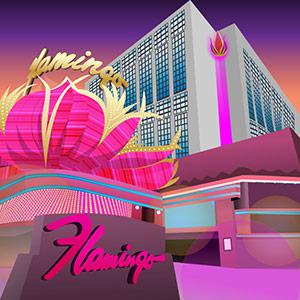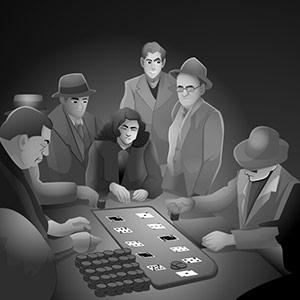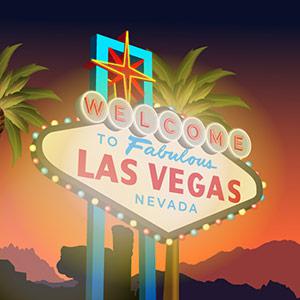Before the high-rise megaresort casino glitz and the neon blitz, the Las Vegas Strip was just a 4.2-mile stretch of empty road leading out of Las Vegas. In the course of the last century, it has been transformed from a dusty trail in the desert into an iconic stretch of dense neon lights and the beating heart of Sin City. Read on for the wild and woolly history of the early Las Vegas Strip.
Vice and Vegas
Where there is vice, there is the mob. When the U.S. government decided that Americans really didn’t need alcohol as much as they thought they did, the Volstead Act ushered in the Prohibition era, which lasted from 1920-1933. These 13 unlucky years for drinkers became a boon for mobsters, who were happy to provide the liquor libations which the government had expressly forbidden. Many historians credit Prohibition for the creation of organized crime. At the very least, the mob business blossomed in the Roaring Twenties.
In 1933, when alcohol became legal again, the profit motive for illegal alcohol waned, and various mobsters decided to go into other forms of vice in the spirit of public service. One such public servant, Benjamin “Bugsy” Siegel, was also public enemy number one. With his background in Murder, Inc. behind him, this Jewish mobster left New York City after the Italian mafia and Jewish mob formed a syndicate. Now he had work to do on the West Coast.
The First Casinos on the Strip

The first casino/resort to be built on the area now known as the Strip was the El Rancho Vegas, which opened in 1941. At a cost of $500,000, El Rancho had 110 rooms, a Spanish-style exterior and a cowboy-themed interior. In addition to horseback riding, the resort had the largest dining room in Las Vegas, a theater, 2 blackjack tables, one roulette table, one craps table, and 70 slot machines.
The second casino/resort to appear on the Strip was the Hotel Last Frontier, built in 1942. The gas station of the hotel featured an antique fire engine with a steel tank on a horse-drawn carriage. The neon sign above the hotel also featured the image of fire engine, with neon horses and all. The hotel was later modernized and renamed the New Frontier. The fire engine and neon sign were replaced by a huge marquis advertising the more tantalizing aspects of the Sin City resort: Bikini Bull Riding, Cold Beer + Dirty Girls Mud Wrestling, and Bone Suckin’ Baby Back Ribs.
The Frontier was one of the longest running casinos in continuous operation on the Strip from 1942 until 2007, when it was torn down by casino mogul Steve Wynn to make way for another resort. Besides the bikini/bull/beer/mud/ribs, the hotel had another claim to entertainment fame: it was the first Vegas hotel to host Elvis Presley on its stage in the 50s. The King probably came for the ribs.
The Mob Stakes a Claim

Bugsy Siegel eyed the legal gambling scene in Las Vegas with much interest. He was pursuing mob partnerships in California at the time, where gambling was illegal, when he stumbled upon a lucrative side project: the Las Vegas Strip. So he partnered with other underworld investors (and a few legitimate front men) and opened the Flamingo on the Strip in 1946 at a cost of $6 million. It was the most luxurious hotel/casino on the Strip at the time, with 105 rooms, including a secret escape ladder built into the ‘Presidential Suite,’ just in case. Over several years, Bugsy over-invested in the Flamingo to the point of debt, but his style, swagger, and chest-puffery began a trend imitated by all casino moguls up to this day. Bugsy Siegel was gunned down in his girlfriend’s apartment in Beverly Hills, California, by an unknown assassin. One mobster was down, but the mob was not finished with Sin City.
More mob casinos
Filling in the gap left by the death of Bugsy Siegel, other mobsters began streaming into Vegas looking for investment opportunities. The Desert Inn was just such an opportunity. Owner Wilbur Clark ran out of money mid-construction, so he turned to notorious Cleveland mobster Moe Dalitz for help. Clark was the official name on the paperwork, but the Desert Inn was 75% owned by the Mayfield Road Mob of Cleveland.
The Desert Inn opened in 1950 as one of the largest hotel casinos on the Strip. The D.I. (as local Sin Citizens called it) was famous for attracting big name entertainment. Frank Sinatra made his first Las Vegas appearance at the D.I.’s Crystal Room in 1951, and quipped, “For six bucks you got a filet mignon dinner and me.” Later the Desert Inn pulled in every major star of the 20th century. It was here at the Desert Inn that Frank Sinatra, Dean Martin, and Sammy Davis Jr held court as the most famous entertainment trio in Las Vegas: the Rat Pack.
Modern Moguls and the End of an Era

The Desert Inn quickly became a legend on the early Vegas Strip. Over the years it changed hands several times and underwent extensive renovations, including a $54-million upgrade by reclusive billionaire Howard Hughes. The enigmatic Hughes spent the last years of his life as a shut-in on the top floor of the hotel, and after his death, the Summa Corporation took over and continued the renovations. Over the years, the Desert Inn served as the setting for several films and television shows, most notably the original Ocean’s 11, starring the Rat Pack, and the TV show Vega$. In 1992, the Desert Inn held a week-long celebration of Frank Sinatra’s 77th birthday.
Over the years the Desert Inn was renovated, expanded, bought, sold, and resold by several casino moguls, including Kirk Kerkorian, and finally Steve Wynn. The D.I. was purchased in the year 2000 by Wynn for $270 million. None of the original 1950s D.I. buildings remained, but the current structures weren’t enough for Wynn. So he destroyed the legendary Desert Inn in a forced implosion, much to the disappointment of locals and visitors alike. The Desert Inn came crashing to the ground In October, 2001, one month after the Twin Towers were destroyed in New York City.
Throughout the boom period of the Strip, several iconic resorts helped put Las Vegas on the map. These hotels include The Dunes, The Sands, The Stardust, and the Sahara. All of these legendary Las Vegas hotel/casinos were built in the 50s and stood in the same spots on the Strip well into the 90s, before being torn down to make way for modern megaresorts. Only the Sahara remains, which operated under the same name for 59 years, until it was renovated and renamed the SLS Las Vegas in 2014.
Americana in Neon
Of all the big changes to the Las Vegas Strip, one thing remains the same: the lights. The same bright neon lights of the Big City found the perfect home along the early Las Vegas Strip. The same types of attention-grabbing giant neon signs that made New York’s Times Square legendary sprung up all along the Las Vegas Strip from the very beginning. As each casino tried to outdo each other, the flashing neon signs became larger, more flamboyant, and extremely artful in their deployment. Every sign on the Strip makes up one of the most iconic stretches of street in the world. So much so that the U.S. Department of Transportation designates the Las Vegas Strip as an All-American Road and a Scenic Route at night.
Welcome to Fabulous Las Vegas

The most famous sign in Las Vegas is the ‘Welcome to Fabulous Las Vegas’ sign on the Strip. Designed in 1959 by Betty Willis, the distinctive sign belongs to an architectural style known as Googie architecture. This post-modern, Atomic Age/Space Age style was fueled by car culture and the concept of the open road as epitomized by Route 66 and other iconic bits of Americana. This style propagated along the Strip and throughout Las Vegas as the dominant style of signage.
The Welcome sign has become a symbol of Las Vegas itself, and millions of tourists each year stop to view the sign and take selfies with it. For many years, the sign remained cut off from foot traffic and was difficult to reach. After spending over $1 million on a preservation project, the Welcome to Fabulous Las Vegas sign area features parking and a paved walkway for easy access.
So many legendary casinos have come and gone on the Las Vegas Strip. And with each renovation, a pile of old neon signs grew in the desert in a neon boneyard. For years, the eerie lines of dead signs from the former boom era of Las Vegas sat in the dust, ignored. Eventually, preservationists and art historians realized they had a rare opportunity for an open-air museum, so in 1996 the Neon Sign Museum was opened to an appreciating public.
Ever-changing Vegas Strip
The ever-changing city of Las Vegas is a strange success story. All of the legendary casinos which once stood proudly along a Strip cutting through an oasis in the desert are gone. They have mostly been replaced by monstrous megaresorts as a testament to the success of Sin City. Legendary entertainers have come and gone, and a new crop of megastars have taken their place. All of the money and star power flowing down the Las Vegas Strip have made the town one of the brightest spots on earth. So much so, that the heavy concentration of neon signs along the Strip can be seen from orbit, burning much brighter than all other cities.




